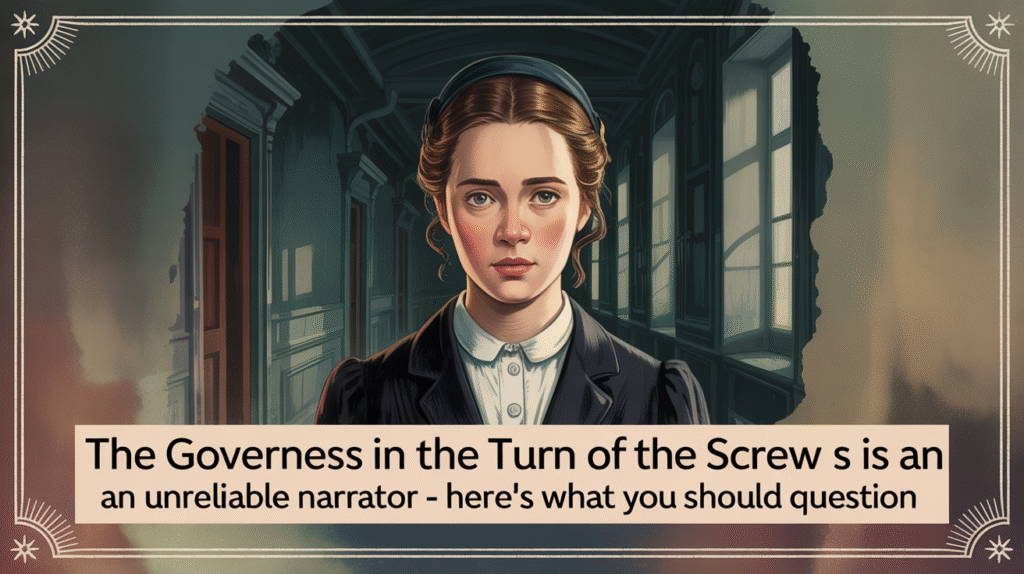The Turn of the Screw is driven by a single narrator, the governess, whose version of events dominates the novella. But how much of what she tells us can we trust?

The answer is: not much without scrutiny. Henry James carefully crafts her as an unreliable narrator, leaving readers in constant doubt about what is real, imagined, or deliberately distorted. This analysis explores the signs of her unreliability, how it shapes the story, and what readers should be questioning.
She Controls the Entire Narrative
The governess’s first-person account is the only lens through which we experience the core events of the novella.
Lack of External Validation
There’s no second opinion or confirmation of what she sees or interprets.
- Other characters like Mrs. Grose never directly witness the ghosts.
- The children never openly acknowledge anything supernatural.
Her Story Comes Through a Manuscript
The manuscript read by Douglas (a second narrator) distances the reader even further from the truth.
- We’re not reading direct dialogue, we’re reading her account of what happened.
- This additional filter introduces doubt right from the prologue.
Her Emotional State Is Frequently Unstable
Throughout the story, the governess swings between confidence and panic, often interpreting innocent events as ominous.
Paranoia and Anxiety
Her mental state deteriorates as she spends more time isolated at Bly.
- She starts believing that everyone is hiding something, including the children.
- Her sense of duty turns into obsession, especially regarding Miles and Flora’s “purity.”
Moments of Delusion
She claims certainty at moments when the evidence is most unclear.
- For instance, her reaction to seeing Peter Quint on the tower becomes a defining “proof,” even though no one else confirms it.
- Her emotional narration frequently skips logical steps or includes conclusions not supported by action.
She Projects Meaning Where There May Be None
The governess often interprets behaviors or words in ways that suit her worldview rather than what’s explicitly shown.
Reading Between the Lines – Too Much
She insists that the children are hiding secrets and “corrupted,” though their behavior often appears innocent.
- Miles’s mature speech is seen as manipulative rather than precocious.
- Flora’s sickness is interpreted as spiritual contamination rather than emotional distress.
Ghosts as Moral Judgment
She believes the ghosts represent a threat to the children’s souls.
- Peter Quint is painted as a predator without direct evidence.
- Miss Jessel is portrayed as a symbol of moral failure rather than a complex character.
Her Authority Goes Unchecked
With no adult supervision from the children’s uncle and little challenge from Mrs. Grose, the governess becomes the absolute authority.
Power Without Balance
Her decisions go unquestioned until the very end.
- She isolates Flora from Mrs. Grose and forces emotional confrontations.
- She monopolizes Miles’s attention, even when it’s clearly affecting him negatively.
A Self-Appointed Savior
She sees herself as the only person who can “save” the children.
- This savior complex escalates the tension and suggests delusion.
- Her desire to be seen as heroic aligns with narcissistic traits.
James Intentionally Obscures Truth
Henry James designed the narrative to raise questions rather than provide clear answers.
Ambiguity Is the Point
The story never confirms whether the ghosts are real.
- Readers are left to decide whether this is a supernatural tale or a psychological breakdown.
- The lack of resolution keeps the reader in a constant state of questioning.
Style Reflects Instability
The prose mimics the governess’s scattered mindset.
- Long, winding sentences and vague language mirror confusion.
- Her narrative style is dramatic, exaggerated, and emotionally charged.
FAQs About the Unreliable Narrator in The Turn of the Screw
Here are some questions and answers about the governess’s reliability as a narrator:
Why is the governess considered unreliable?
She’s the only source of information and shows signs of paranoia, emotional instability, and projection. She interprets events without evidence, and no other characters validate her claims.
Are the ghosts real or imagined?
That’s the core ambiguity. The text never proves the ghosts exist, only that the governess sees them. The reader must decide whether her visions are supernatural or symptoms of mental strain.
What are some signs of her unreliability?
She frequently makes sweeping conclusions, becomes obsessed with the children’s morality, and isolates herself. Her narration is emotional rather than factual.
Does Henry James want us to doubt her?
Yes. James structured the novella to leave readers uncertain. The use of a frame narrative, vague language, and exclusive POV all point to deliberate ambiguity.
Could she be telling the truth despite her instability?
Possibly. Unreliable doesn’t mean dishonest, it could mean she’s reporting her truth, distorted by fear or psychological stress. The beauty of the novella lies in this complexity.
The governess’s unreliability isn’t a flaw, it’s the engine of The Turn of the Screw. By keeping us inside her mind without ever confirming her reality, Henry James creates a narrative of tension, uncertainty, and psychological depth. The more closely you read, the more you realize: the scariest thing in the book may not be the ghosts, it’s not knowing whether they were ever there at all.
